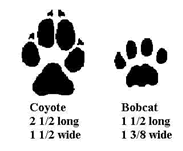Although bobcats are considered a game species, they are currently classified as “Endangered” in New Jersey and are therefore managed by the Division of Fish and Wildlife’s Endangered and Nongame Species Program. There is no open hunting or trapping season for bobcat, and it is illegal to intentionally take, kill or attempt to take or kill one in the state. Bobcats legally harvested in other U.S. states or Canadian provinces may be possessed provided the pelt is affixed with a CITES tag from the state or province of harvest.
Bobcats thrive in a variety of habitats with high prey abundance and dense understory vegetation, including hardwood forests, mixed forests, shrubs, wetlands, riparian areas, and field edges. Forest edges and rocky ledges and outcrops are also important terrain features. Like many animals, bobcats will often use game trails when traveling through forests, fields and thickets.
Bobcats are widely distributed across northern New Jersey, but the core of their range is in the northwestern counties of Sussex, Warren, Passaic and Morris. Trappers should make every reasonable effort to avoid taking bobcats, and should know what to do if a bobcat is accidentally captured.
Back feet often follow in the front foot tracks of bobcats. Bobcat track trails tend to “wander” compared with the more straight-line patterns of wild canids (foxes and coyotes). Bobcats travel and hunt with a deliberate and methodical walking pattern, rarely bounding unless chasing prey. Bobcat tracks are approximately 1½ – 2½ inches long and 1 3/8 – 2½ inches wide. Bobcats have 4 toe pads on the front and hind feet. Claw marks typically do not show in tracks as they do with canids. The bobcat track is circular in shape compared to oval-shaped canid tracks and the bobcat track heel pad resembles an upside down ‘W’. The “X” test: in canids you can draw an X through the track without touching the foot pad. In felids you cannot draw an X through the track without hitting the foot pad.

Information to Help Avoid Bobcat Captures
Wherever a bobcat track is identified, cable restraint sets should not be made in close proximity.
- Bobcats will repeatedly use the same travel corridors within their territories, so sets should not be made on or near existing bobcat sign.
- Bobcats tend to use areas where prey animals are abundant. Prey include mice, voles, moles, squirrels, chipmunks and rabbits, among others. Trail sets that are effective for wild canids (fox and coyote) can be expected to capture bobcats as cats will follow canine trails, particularly those in open fields.
- Lures and baits that appeal to one species appeal to others as well. Visible baits of any kind, especially rabbits or parts of rabbits, should not be used if any bobcats frequent the area. Sight-attractants such as bird wings, feathers, pieces of fur, should not be used near the traps if bobcat may be present.
- The use of tainted rather than fresh meat baits provides significant attraction to coyotes and foxes but tends not to attract bobcat.
Reducing Mortality and Injuries to Incidentally Captured Bobcats
If you find a bobcat (alive or dead) in one of your sets, call: 877-WARN-DEP (877-927-6337). The dispatcher will record your name and phone number, and then will pass along the information to the appropriate biologist, who will respond immediately to release/remove the bobcat from the cable restraint.
We advise that you do not attempt to release a live bobcat from your cable restraint as the animal will struggle and may be injured. Even an apparently uninjured bobcat may have injuries that are not detectable and the animal may run off and die. Only if the animal appears to be in distress do we advise that a trapper attempt to release a live bobcat from a cable restraint following the guidance below. If you find a live bobcat in your cable restraint and the animal is not struggling and does not appear to be in distress, slowly and quietly back away from the area and call the number above. A biologist will respond to remove the animal from the cable restraint.
It is extremely important that a live bobcat be released as soon as possible after capture to prevent injury or death to the animal that might result from a prolonged time spent in the trap device. DNA samples will be taken from captured bobcats to help the Division better understand the health and status of the New Jersey population.
How to Release a Snared Bobcat
- Every trapper should have and carry a catchpole and wire cutters as part of their basic trapline equipment to allow the safe release of any unintended animal captures.
- Approach a cable restrained bobcat slowly to avoid causing them to move about excessively.
- Slowly and carefully slip a catchpole loop over the bobcat’s head and close the loop just enough to hold the animal without choking it. You do not want to choke the animal out but merely hold it securely.
- Place the catchpole on the ground and step on it to hold the animal’s head down. Place a heavy piece of canvas or carpet over the bobcat’s body to restrain its rear legs being careful not to apply excessive pressure but just enough to immobilize the animal while you release the cable restraint.
- Once restrained, quickly cut the cable to release the bobcat. Release the loop on the catchpole and allow the animal to escape.
- Please use caution when attempting to release a cable restrained bobcat as they are able to inflict serious injury if not handled carefully.
- The safest way to release a bobcat is to contact the Division of Fish and Wildlife and request assistance. Biologists have specialized equipment and are trained to remove bobcats from cable restraints with minimal stress and injury to the animals.
 Official Site of The State of New Jersey
Official Site of The State of New Jersey
